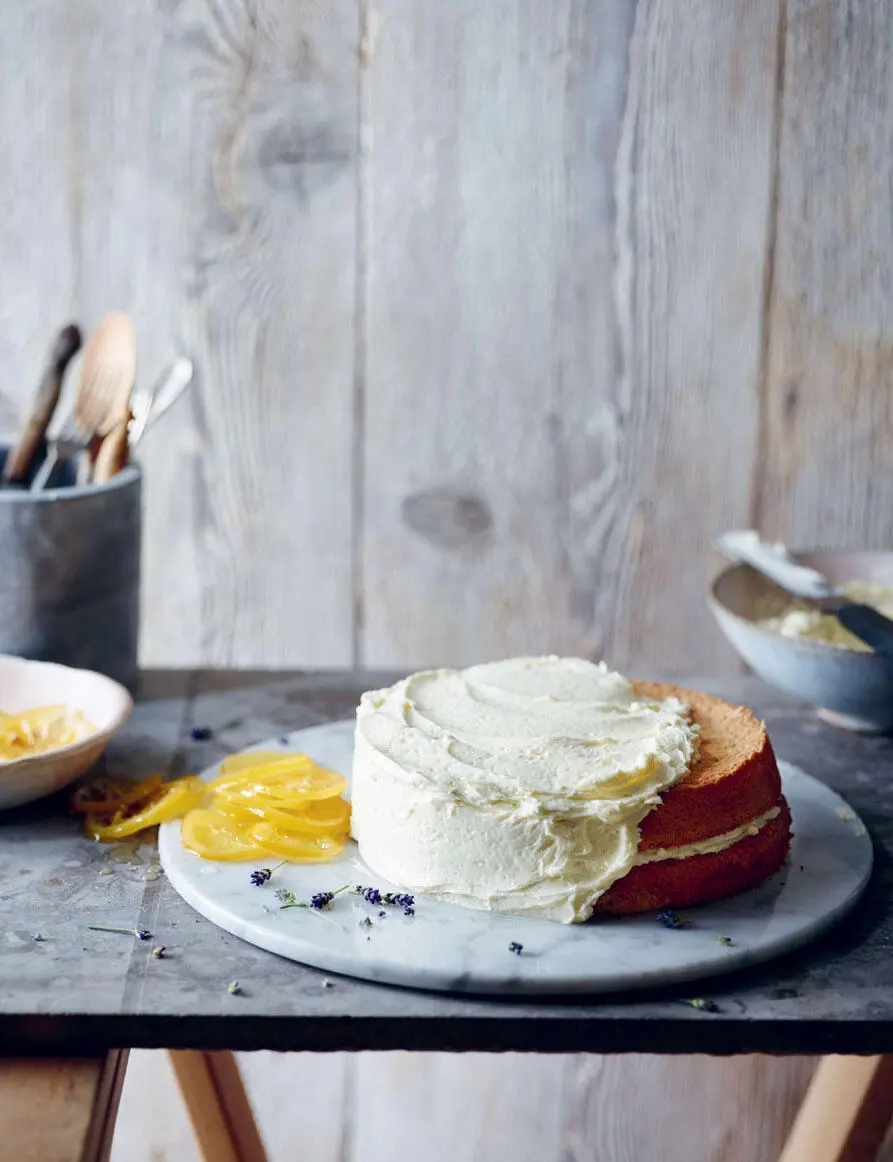Serves 8–10
25g (1oz) butter, melted and cooled, plus extra for greasing
3 large eggs
90g (3¼oz) caster sugar
zest of 2 lemons
½ tsp culinary lavender, plus extra for sprinkling
75g (2½oz) plain flour
For the candied lemons
1 small lemon, thinly sliced
150g (5½oz) caster sugar
For the meringue buttercream
2 large egg whites
120g (4¼oz) icing sugar
240g (8¾oz) unsalted butter, cut into large dice and left to soften a little
½ tsp vanilla extract
two 18cm (7in) sandwich tins
1. Make the candied lemons in advance, as they will keep for a while. Boil a pan of water and drop in the lemon slices. Blanch for 1 minute, then lift them out carefully with tongs and leave them to drain.
2. Heat 150ml (5fl oz) water in a saucepan over a medium-high heat and add the sugar. Stir until the sugar has dissolved. Drop in the lemon slices and leave them to simmer gently for 20 minutes or until the skin is softened and sweet. Remove from the syrup using tongs and leave to dry on a piece of baking parchment.
3. Preheat the oven to 180°C (350°F) Gas mark 4. Grease the sides of the tins, and line the bases with baking parchment. Pour water into a saucepan to about 4cm (1½in) deep and bring it to the boil. Put the eggs and sugar in a large heatproof glass mixing bowl. Take the pan off the heat and put the mixing bowl over the pan, making sure the base of the bowl doesn’t touch the water.
4. Using an electric beater, whisk the mixture until light and frothy. This will take 4–5 minutes, and when you lift the beaters out of the mixture, the batter dripping off the beaters should leave an impression for 3 seconds. At this point, take the bowl off the hot pan and continue whisking until the mixture is completely cold.
5. Sprinkle in the lemon zest and lavender, then sift half the flour directly over the top of the mixture. Fold in, then add half the melted butter. Repeat to add the remaining flour, then butter, folding carefully so that you don’t knock too much air out of the mixture.
6. Divide the batter evenly between the two prepared tins. Bake for 12–13 minutes until the cakes are shrinking away from the sides of the tins and are golden and firm to the touch on top. Remove from the oven and put a clean tea towel over the tins. After 5 minutes, turn them out on a wire rack and leave them to cool completely. If you aren’t decorating them immediately, wrap them in cling film once they are cool – they will go stale quickly as they don’t have much fat in them.
7. To make the meringue buttercream, prepare a saucepan of hot water as before. Put the egg whites in a clean grease-free glass bowl and sift in the icing sugar. Whisk over the hot water until you have stiff peaks. Remove from the pan and whisk until completely cold. At this point, begin to add the butter, one piece at a time, whisking in before adding the next. This will take about 5 minutes. Once you have added all the butter, whisk in the vanilla extract.
8. Spread about a quarter of the buttercream on top of one cake and put the other cake, base-side up, on top. Spread the remaining buttercream around the sides and on top of the cake. Lay the candied lemon slices on top and sprinkle with a little lavender.

Spiced pumpkin cake with cream cheese icing
Bake this wonderful cake when the weather turns chilly and pumpkins are at their best. Warmed with gentle spices, which are contrasted against a pure cream cheese topping, this is a comforting, autumnal delight.
Serves 8
275g (10oz) pumpkin (peeled and deseeded weight), grated
175g (6oz) plain flour
2 tsp baking powder
1 tsp ground ginger
1 tsp ground cinnamon
125g (4½oz) butter, melted
200g (7oz) soft light brown sugar
2 eggs
salt
For the cream cheese icing
250g (9oz) cream cheese
250g (9oz) icing sugar
900g (2lb) loaf tin
1. Preheat the oven to 180°C (350°F) Gas mark 4. Grease and line the base and sides of the loaf tin with baking parchment. Put a double layer of kitchen paper on a large plate. Check that you have the correct amount of grated pumpkin. Spread the pumpkin over the paper on the plate and leave to stand, to remove any excess moisture, while you prepare the remaining ingredients.
2. Sift the flour, baking powder, ginger, cinnamon and a pinch of salt into a bowl. Pour the butter into another bowl and add the sugar and eggs, then whisk to combine well. Add the grated pumpkin, then pour all of this wet mixture into the dry ingredients and stir to combine.
3. Pour into the prepared loaf tin and bake in the centre of the oven for 80–90 minutes until deep golden brown and cooked in the centre and a skewer inserted into the centre comes out clean.
4. Leave to cool in the tin on a wire rack for 10 minutes. Remove from the tin and leave on the wire rack to cool completely. Remove the paper.
5. Meanwhile, to make the icing, put the cream cheese in a bowl and sift in half the icing sugar. Mix to combine, then add the remaining icing sugar and mix again. Spread over the top of the cake. Cut into slices to serve.
Smørkage
This divine treat encompasses some of my very favourite ingredients: butter, almonds cardamom and custard. Hailing from Denmark, there are many different versions of this cake, which are often enjoyed for brunch with hot coffee. Some of them are baked in a bundt tin and are then named butter ring. This is my version of the recipe and, although it does involve a few steps and a bit of time, I promise it is worth every single minute. What a treat this is – it might just be my favourite recipe in the book!
Serves 8–10
150ml (5fl oz) milk, lukewarm
50g (1¾oz) soft light brown sugar
25g (1oz) fresh yeast or 12g (½oz) active dried yeast
350g (12oz) strong white bread flour, plus extra for dusting
½ tsp salt
½ tsp ground cardamom
1 egg, beaten, plus 1 egg for the glaze
150g (5½oz) butter, cubed, plus extra for greasing
15g (½oz) almonds with skins
For the custard
250ml (9fl oz) milk
1 vanilla pod or 1 tsp vanilla extract
1 egg
50g (1¾oz) caster sugar
20g (¾oz) plain flour
For the almond paste
100g (3½oz) butter, softened
150g (5½oz) soft light brown sugar
100g (3½oz) ground almonds
6–8 drops almond extract, to taste
For the icing
150g (5½oz) icing sugar, sifted
¼ tsp ground cardamom
1–2 tbsp boiling water
23cm (9in) springform cake tin; baking tray
1. Pour the milk into a bowl, stir in the sugar and crumble in the yeast. Leave to stand for 5 minutes until creamy. Sift the flour, salt and the cardamom into the bowl of a stand mixer with a dough hook. Add the beaten egg to the yeast mixture and pour on to the dry ingredients, then mix thoroughly until combined.
2. While mixing, add the butter, bit by bit until combined. It should be springy when you press the dough with your finger. The mixture will also come away from the sides of the bowl. It will take about 10 minutes.
3. Cover the bowl with cling film and leave to rise for 1 hour or until the dough has doubled in size. (Alternatively, put it into the fridge overnight.) The dough is ready when, having pressed it with a floured finger, the dent remains.
4. Meanwhile, make the custard. Pour the milk into a saucepan over a medium-high heat and add the vanilla pod (but not the vanilla extract). Bring to just boiling, then take the pan off the heat and leave the vanilla to infuse the milk for 5 minutes. Put the egg in a bowl, add the sugar and sift in the flour, then whisk for 1 minute until light.
Читать дальше













